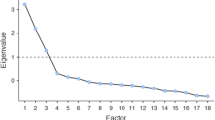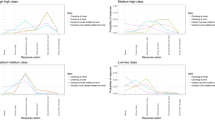Abstract
This mixed method study considers the effect of high-frequency (HF) smartphone use on homework behavior. Analyzing 393 surveys and an additional 210 semi-structured interviews conducted with undergraduates, this study explores the relationship between excessive smartphone use and homework at a college in New York City. Bivariate analyses indicate that students who check their phone more than 39 times a day report that smartphone use interferes with homework compared to those who check their phones less than 39 times a day. Semi-structured interviews also indicate excessive smartphone use interferes with homework. Other factors such as employment, number of courses taken, amount time spent at school, family obligations, and socializing all appear to affect if and when homework is undertaken. Nested within this web of obligations and activities is the frequency of smartphone use, which HF smartphone users claim interferes with homework. This research illuminates how often students use smartphones in relation to their daily life and their class assignments. The findings provide teachers, administrators, counselors, students, and other preliminary indication of how smartphones influence the initiation and completion of class assignments.
Similar content being viewed by others
References
Al-Barashdi, H. S., Bouazza, A., & Jabur, N. H. (2015). Smartphone addiction among university undergraduates: a literature review. Journal of Scientific Research & Reports, 4(3), 210–225.
Barth, F. D. (2015). Social media and adolescent development: hazards, pitfalls and opportunities for growth. Clinical Social Work Journal, 43(2), 201–208.
Ben-Yehuda, L., Greenberg, L., & Weinstein, A. (2016). Internet addiction by using the smartphone-relationships between internet addiction, frequency of smartphone use and the state of mind of male and female students. Journal of Reward Deficiency Syndrome and Addiction Science, 2(1), 22–27.
Brigitte, J., & Christel, G. (2007). Time management. Personnel Review, 36(2), 255–276.
Carr, N. (2017). How smartphones hijack our minds. The Wall Street Journal. Retrieved October 18, 2017 from https://www.wsj.com/articles/how-smartphones-hijack-our-minds-1507307811
Choi, H. S., Lee, H. K., & Ha, J. C. (2012). The influence of smartphone addiction on mental health, campus life and personal relations: focusing on K university students. Journal of the Korean Data and Information Science Society, 23(5), 1005–1015.
Choliz, M. (2010). Mobile phone addiction: a point of issue. Addiction, 105(2), 373–374.
Creswell, J. W. (1994). Research design: Qualitative, quantitative, and mixed method. London: Sage Publications.
David, P., Kim, J. H., Brickman, J. S., Ran, W., & Curtis, C. M. (2015). Mobile phone distraction while studying. New Media & Society, 17(10), 1661–1679.
Demirci, K., Orhan, H., Demirdas, A., Akpinar, A., & Sert, H. (2014). Validity and reliability of the Turkish version of the smartphone addiction scale in a younger population. Bulletin of Clinical Psychopharmacology, 24(3), 226–234.
Duhigg, C. (2012). The power of habit: Why we do what we do in life and business. New York: Random House.
Lepp, A., Barkley, J. E., Sanders, G. J., Rebold, M., & Gates, P. (2013). The relationship between cell phone use, physical and sedentary activity, and cardiorespiratory fitness in a sample of US college students. International Journal of Behavioral Nutrition and Physical Activity, 10(1), 79 Retrieved October 11, 2017 from https://ijbnpa.biomedcentral.com/articles/10.1186/1479-5868-10-79.
Levine, L. E., Waite, B. M., & Bowman, L. L. (2007). Electronic media use, reading, and academic distractibility in college youth. Cyber Psychology & Behavior, 10(4), 560–566.
Lindesmith, A. R. (1968). Addiction and opiates. Chicago: Aldine Publishing Company.
Newport, F. (2015). Most U.S. smartphone owners check phone at least hourly. Retrieved May 1, 2017 from http://www.gallup.com/poll/184046/smartphone-owners-check-phoneleast-hourly.aspx
Reed, P., & Reay, E. (2015). Relationship between levels of problematic internet usage and motivation to study in university students. Higher Education, 70(4), 711–723.
Sales, N. J. (2016). American girls: Social media and the secret lives of teenagers. New York: Alfred A. Knopf.
Schor, J. (1991). The overworked American: The unexpected decline of leisure. New York: Basic Books.
Schwartz, T. (2015). Addicted to distraction: The story of how I lost, and found, my focus. New York Times. Retrieved October 18, 2017 from https://www.nytimes.com/2015/11/29/opinion/sunday/addicted-to-distraction.html
Stafford, T. (2006). Why email is addictive (and what to do about it). Neuroscience and Psychology News and Views. Retrieved May 1, 2017 from https://mindhacks.com/2006/09/19/why-email-is-addictive-and-what-to-do-about-it/
Tossell, C. C., Kortum, P., Shepard, C., Rahmati, A., & Zhong, L. (2015). You can lead a horse to water but you cannot make him learn: smartphone use in higher education. British Journal of Educational Technology, 46(4), 713–724.
Wang, S. S. (2015). Never procrastinate again: new research sheds light on the emotions behind our daily tactics and how we can tackle them. Wall Street Journal. Retrieved October 18, 2017 from https://www.wsj.com/articles/to-stop-procrastinating-start-by-understanding-whats-really-going-on-1441043167
Wilmer, H. H., Sherman, L.E.,& Chein, J.M. (2017). Smartphones and cognition: A review of researchexploring the links between mobile technology habits and cognitive functioning. Frontiers in Psychology, 8(605), 1-16. https://doi.org/10.3389/fpsyg.2017.00605.
Wood, W., & Neal, D. T. (2007). A new look at habits and the habit-goal interface. Psychological Review, 114(4), 843.
Wood, E., Zivcakova, L., Gentile, P., Archer, K., De Pasquale, D., & Nosko, A. (2012). Examining the impact of off-task multi-tasking with technology on real-time classroom learning. Computers & Education, 58(1), 365–374.
Wu, T. (2016). The attention merchants: The epic scramble to get inside our heads. New York: Alfred A. Knopf.
Acknowledgements
We are deeply grateful and thank the student researchers and all their fellow student interviewees who generously granted interviews. Without their diligent efforts, this study would not have been possible.
Author information
Authors and Affiliations
Corresponding author
Rights and permissions
About this article
Cite this article
Furst, R.T., Evans, D.N. & Roderick, N.M. Frequency of College Student Smartphone Use: Impact on Classroom Homework Assignments. J. technol. behav. sci. 3, 49–57 (2018). https://doi.org/10.1007/s41347-017-0034-2
Published:
Issue Date:
DOI: https://doi.org/10.1007/s41347-017-0034-2




